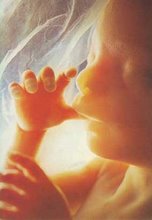Do you know why Our Lady of Guadalupe is the Patroness of the Unborn?
The next series of articles feature Fr. Frank Pavone's letter that appears in the Aug.-Sept. special edition newsletter of the San Juan Diego Women's Center. Fr. Pavone writes about the power of the image of Our Lady of Guadalupe in converting hearts to Christ. Just as it had converted the Aztecs and put an end to their human sacrifice, the image of Our Lady of Guadalupe continues to work powerfully to put an end to abortion through the Pro-Life Movement.
A Surprising Image
If you are involved in the pro-life movement for any length of time, you will encounter the image of Our Lady of Guadalupe. There are many connections between this particular image of Our Lady and the pro-life cause.
On December 12, 1531, the Blessed Virgin Mary appeared to an Indian named Juan Diego and requested that a shrine be built and dedicated to her on the Hill of Tepeyac. Juan Diego, upon reporting this event to the bishop, was disappointed because the bishop didn't seem to believe him. Juan returned to the place of the apparition where Our Lady again appeared. She told him to return the next morning when she would give him a sign that would convince the bishop of the truth of her appearance and her request.
The following morning Our Lady told Juan to go to the top of the hill and gather Castilian roses that he would find there. Although he knew that only cactus grew there, he obeyed, and his simple faith was rewarded by the sight of beautiful roses growing where she had told him they would be. He gathered them and showed them to Our Lady who rearranged them for him. Juan returned to the bishop. As he opened his tilma (a type of poncho), the roses fell to the floor. All who were present were startled to see an image of Our Lady on the tilma.
Today this image is still preserved on Juan Diego's tilma, which hangs over the main altar in the basilica at the foot of Tepeyac Hill just outside of Mexico City. In the image, Our Lady is pregnant, carrying the Son of God in her womb. Her head is bowed in homage, indicating that she is not the Goddess, but rather the one who bears and at the same time worships the one true God. Many articles have been written on dozens of other theological lessons drawn from the details of the image.
When asked who the lady was, Juan replied in his Aztec dialect, "Te Coatlaxopeuh," which means "she who crush the stone serpent." His answer recalls Gen. 3:15 and the depictions of Mary as the Immaculate Conception, her heel on the serpent's head. The devil exalts himself above God and above God's law (see Isaiah 14:12-15), whereas Mary submits to God (see Luke 1:38). Some promote abortion as a "choice." Self-will is exalted. We reject abortion because we, like Mary, submit all our choices to God. That spirit of obedience crushes evil and sin. Our Lady's image reminds us to live in that obedience each day.
Human Sacrifice Then and Now
Some nine million Aztecs were converted to Christ by the power of the image of Our Lady of Guadalupe. At that time, the Aztec peoples were practicing human sacrifice. As a result of the image's presence among the people, their hearts were converted to the true God and the practice of human sacrifice was abolished. A key theological dynamic operating here is that Our Lady turned the Aztecs from a worldview of despair to one of hope, from a conviction that the gods were against them to a conviction that God was so much for them that He became one of them.
We can listen to stories of Aztecs cutting out their victims' hearts or placing their heads on poles and say, "Oh, how terrible that was!" But America is not doing any better, as the hearts and heads of innocent babies are destroyed by abortion! The image is therefore being used again to change the hearts of our people.
Fr. Frank Pavone, National Director, Priests for Life
.jpg)
